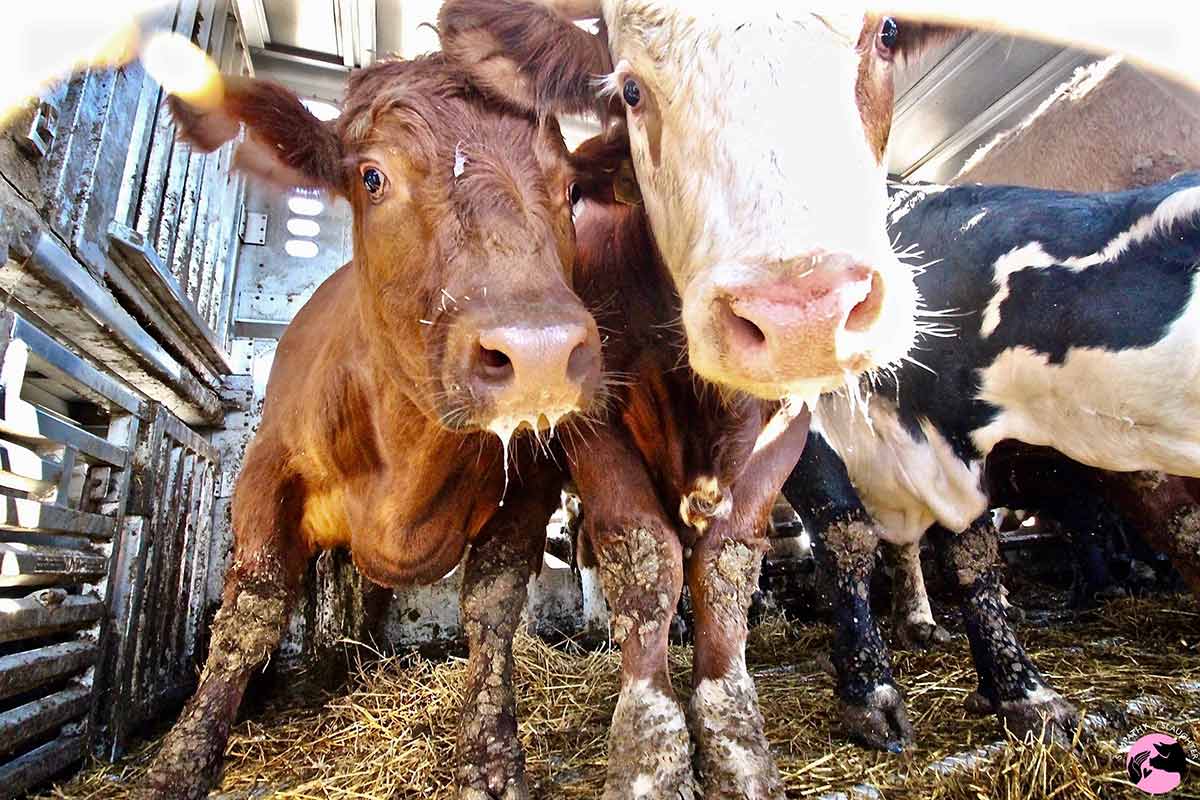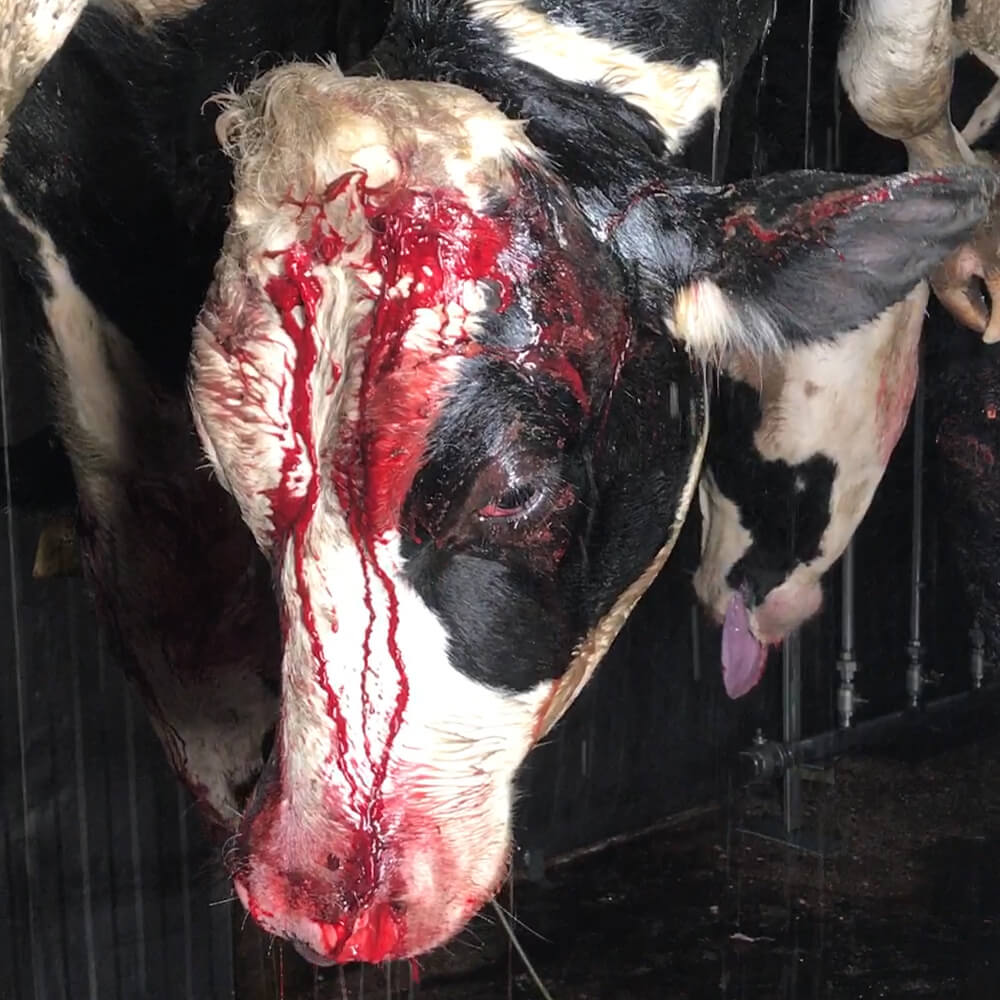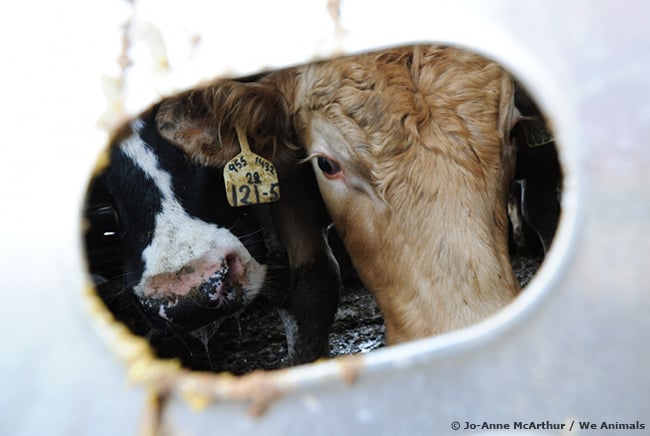Just Released: Cows Suffer on JBS Trucks for Hours Before Slaughter
By 9 a.m. on a cold October morning in Nebraska, nearly half a dozen trucks—crammed full of terrified cows slated for a gruesome death—were already lined up at a JBS slaughterhouse. It’s unknown how long these animals—surely stressed and possibly dehydrated—languished.
Confused and afraid, these cows killed for their flesh suffer long before workers hang them upside down, slit their throats, and bleed them out on the kill floor.

Two whistleblowers have alerted PETA to alleged shoddy transport procedures at a JBS facility in Grand Island, Nebraska, claiming that the slaughterhouse forced cows to wait outside on trucks for up to 10 hours before workers killed them.
The trip from a feedlot to a slaughterhouse can take hours on its own. Many animals on trucks die from heatstroke in warmer months or freeze to death in the winter. Others sustain debilitating broken bones and internal injuries when other animals—fearing for their lives—trample them in an attempt to escape the living hell that they’re in. Even after such a grueling trip, it’s common practice for slaughterhouses to keep animals waiting inside the severely crowded trucks.
PETA has received Freedom of Information Act responses from the complaints that we sent to the Food Safety and Inspection Service (FSIS) on the matter. The documents seem to back up what we have known for years: JBS keeps cows on trucks for long stretches of time before slaughtering them.
Imagine being held inside a cramped, dingy trailer before enduring a gruesome death.
On a visit to the plant, an FSIS official said that when he’d finished his inspection at 9 a.m., five trucks were waiting to unload. If they were already backed up that early in the day, it seems likely that backups get far worse.
FSIS officials asked the plant manager for instances in which cows spent “8 hours or more parked” at the plant—which appears to indicate that it’s common knowledge among FSIS and plant management that trucks may wait there for several hours.
Another FSIS official wrote that trailers “do not get to the plant in a stream”—they know that trucks come in waves and that backup can occur when many arrive at once. The whistleblowers reported to PETA that trucks spend most of their time waiting along the road just outside the plant, and the FSIS district manager wrote of backups, “[I]f it is happening outside the official premises, there is no way [plant FSIS personnel] would know” anything about it.
Not one of the five drivers queried by FSIS in June had a scheduled delivery time. After eight months of our complaints, media coverage of the issue, and FSIS involvement, JBS was still not scheduling trucks’ arrival to ensure minimum wait times.
Here are just a few instances in which this same JBS facility has routinely botched cow slaughters:
- In 2017, PETA received photographs and video footage captured by a whistleblower inside the plant revealing incidents in which cows were mis-shot with a captive-bolt gun. The whistleblower also revealed at least one instance in which workers hung a fully conscious cow—who was bleeding from a hole in her head—upside down before her throat was slit.

- In 2018, we sent a letter calling on the U.S. attorney for the District of Nebraska to investigate the slaughterhouse for habitual violations of the Humane Methods of Slaughter Act and, as appropriate, file federal criminal charges against the facility and the workers responsible for causing abhorrent animal suffering.
- Also in 2018, FSIS cited JBS when workers shot a downed cow in the head three times before the animal fell unconscious.
- In June 2020, FSIS cited JBS yet again when workers botched the shooting of a steer who tried desperately to escape slaughter. JBS workers left the animal standing, walking, and bleeding from the head. Thirteen minutes passed before they repositioned the terrified steer for a second shot.
If this is just a sample of what authorities have caught JBS workers doing, imagine what they do to cows when no one is watching.
Cows—with all their emotions and personality—want to live. They don’t want to take this journey of no return.
We must do better. Cows have best friends and hold grudges against humans who’ve treated them poorly and other animals. The mother/calf bond is particularly strong, and there are countless reports of mother cows who’ve continued to bellow and search frantically for their babies after they’ve been taken away and sold to veal or beef farms.
These gentle giants mourn the deaths of loved ones, sometimes shedding tears over their loss. It’s depressing to think about grieving cows who see others killed right in front of them. But it’s a reality we must face.
This is why PETA is helping people go vegan.
Order our free vegan starter kit. We have all the resources necessary to support folks in ditching meat, eggs, and dairy. You can make a real difference and save nearly 200 animals a year—simply by not eating them!
Want to do more? Support our action to close slaughterhouses:


